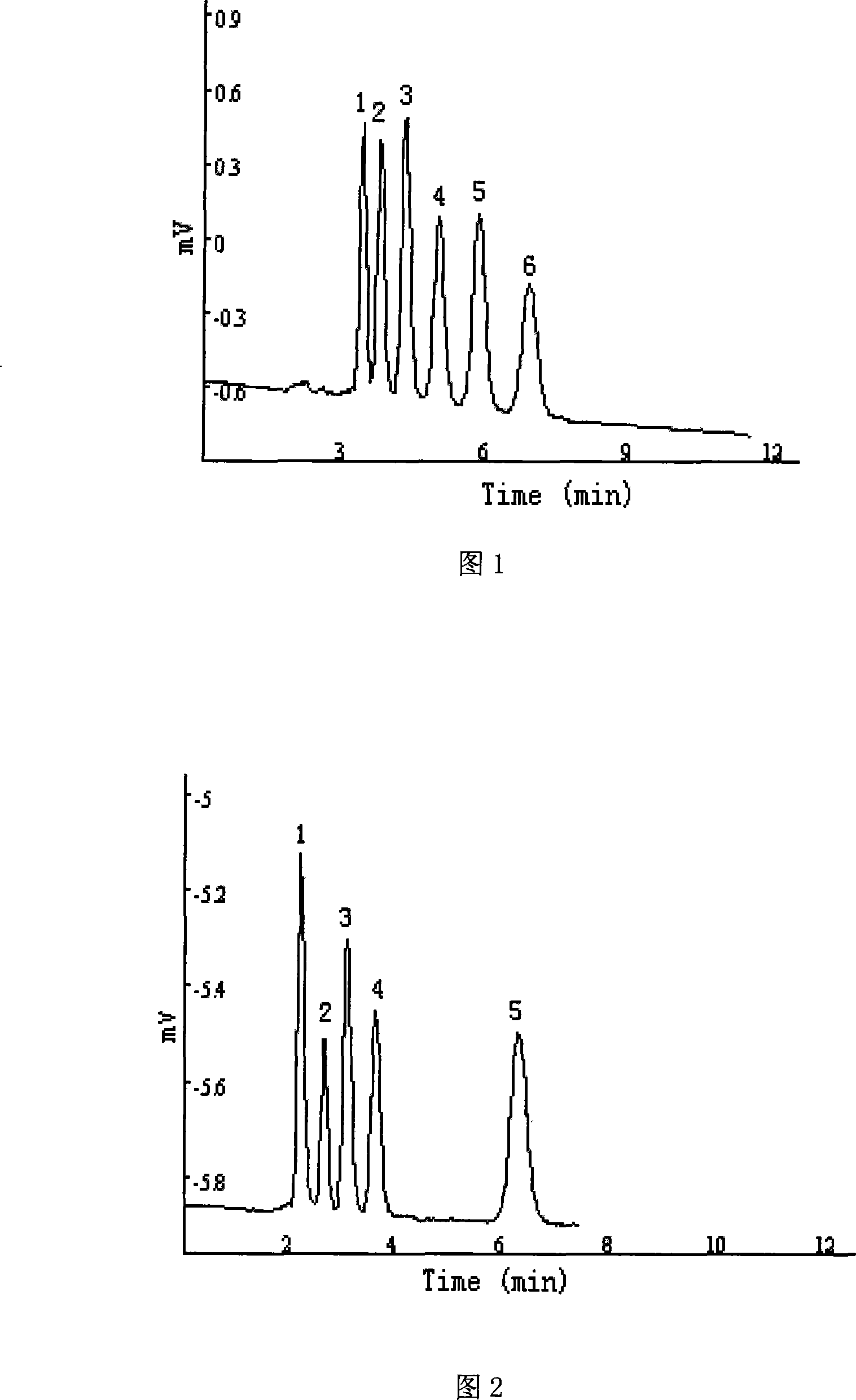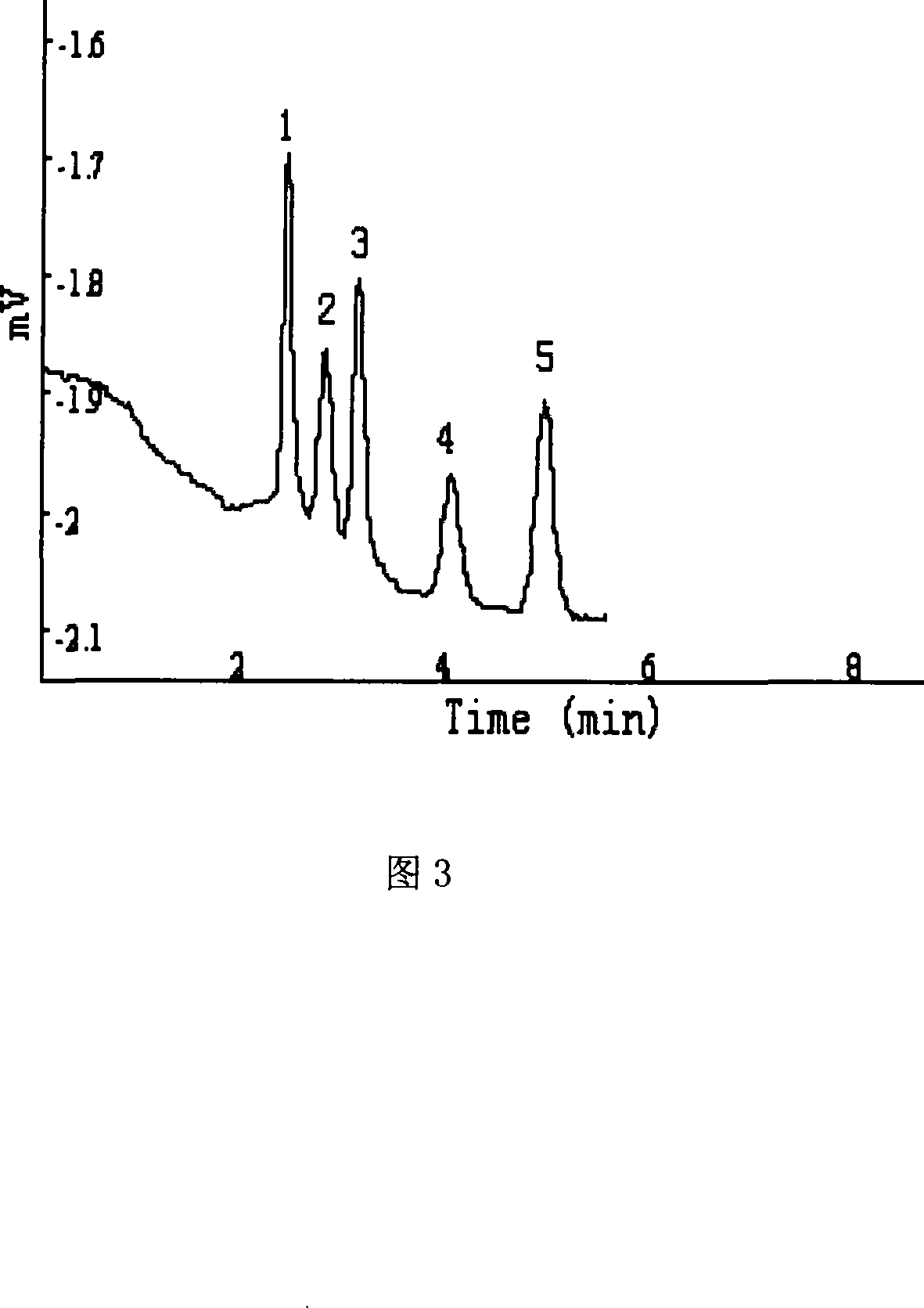Raw material prescription of opposite phase anion exchange electric chromatograph integral column and preparation thereof
A monolithic column and electrochromatography technology, applied in the field of electrochromatography, can solve the problems of cumbersome and time-consuming steps, and achieve the effect of simple process, good column permeability and less time
- Summary
- Abstract
- Description
- Claims
- Application Information
AI Technical Summary
Problems solved by technology
Method used
Image
Examples
Embodiment 1
[0020] 1. Pretreatment of capillaries
[0021] First rinse the empty capillary column with 0.1mol / L HCl solution for about 30min, then rinse with deionized water for 10min, until the pH is equal to 7.0, rinse with 0.1mol / L NaOH for 3h, then rinse with methanol for 15min, blow dry with nitrogen and set aside . Then add a 1:1 mixture of methanol and methacryloxypropyltrimethoxysilane to the capillary treated in step 1, and react at 60°C for 24h. Then rinse with methanol for 15 min, and blow dry with nitrogen at 25°C.
[0022] 2. In-column synthesis
[0023] Isobutyl methacrylate, N-allyl dimethylamine, ethylene glycol dimethacrylate, N, N-dimethylformamide and 1,4-butanediol are respectively 12.0% by weight , 12.0%, 16.0%, 30.0%, and 30.0% were mixed, and the amount of added initiator azobisisobutyronitrile (AIBN) was 0.3% of the amount of polymer monomer. After the mixture was ultrasonically oscillated for 15 minutes, the reaction solution was Inject into a capillary of a c...
Embodiment 2
[0025] Isobutyl methacrylate, N-allyl dimethylamine, ethylene glycol dimethacrylate, N, N-dimethylformamide and 1,4-butanediol are respectively 10.0% by weight , 10.0%, 20.0%, 30.0%, and 30.0% were mixed, and the amount of added initiator azobisisobutyronitrile (AIBN) was 0.3% of the amount of polymer monomer. After the mixture was ultrasonically oscillated for 15 minutes, the reaction liquid Inject into a capillary of a certain length that has been treated according to step 1, seal both ends of the capillary, and immerse in a water bath at 60°C for 8 hours of reaction. After the reaction is complete, the column is rinsed with methanol to remove possible residual reagents in the capillary.
Embodiment 3
[0027] Isobutyl methacrylate, N-allyl dimethylamine, ethylene glycol dimethacrylate, N, N-dimethylformamide and 1,4-butanediol are respectively 10.0% by weight , 10.0%, 20.0%, 20.0%, and 40.0% were mixed, and the amount of added initiator azobisisobutyronitrile (AIBN) was 0.3% of the amount of polymer monomer. After the mixture was ultrasonically oscillated for 15 minutes, the reaction solution was Inject into a capillary of a certain length that has been treated according to step 1, seal both ends of the capillary, and immerse in a water bath at 60°C for 8 hours of reaction. After the reaction is complete, the column is rinsed with methanol to remove possible residual reagents in the capillary.
PUM
 Login to View More
Login to View More Abstract
Description
Claims
Application Information
 Login to View More
Login to View More - R&D
- Intellectual Property
- Life Sciences
- Materials
- Tech Scout
- Unparalleled Data Quality
- Higher Quality Content
- 60% Fewer Hallucinations
Browse by: Latest US Patents, China's latest patents, Technical Efficacy Thesaurus, Application Domain, Technology Topic, Popular Technical Reports.
© 2025 PatSnap. All rights reserved.Legal|Privacy policy|Modern Slavery Act Transparency Statement|Sitemap|About US| Contact US: help@patsnap.com


